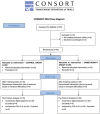Can Supervised Pelvic Floor Muscle Training Through Gametherapy Relieve Urinary Incontinence Symptoms in Climacteric Women? A Feasibility Study
- PMID: 34461664
- PMCID: PMC10301951
- DOI: 10.1055/s-0041-1733979
Can Supervised Pelvic Floor Muscle Training Through Gametherapy Relieve Urinary Incontinence Symptoms in Climacteric Women? A Feasibility Study
Abstract
Objective: To investigate the feasibility of pelvic floor muscle training (PFMT) through gametherapy for relieving urinary symptoms of climacteric women with stress or mixed urinary incontinence (UI).
Methods: Randomized clinical trial, divided into two groups: Gametherapy (G_Game) and Control (G_Control). Both groups received recommendations about unsupervised PFMT, and G_Game also received supervised PFMT through gametherapy. After 5 consecutive weeks, the feasibility was investigated considering participant adherence, urinary symptoms (evaluated by the International Consultation on Incontinence Questionnaire-Urinary Incontinence Short Form [ICIQ-UI-SF] questionnaire), and pelvic floor function (PERFECT Scheme: power, endurance, repetition and fast). The Fisher exact, Kruskal-Wallis, Wilcoxon sign paired, and Mann-Whitney U tests were used by intention-to-treat analysis, using STATA 15.1 (StataCorp, College Station, TX, USA) software.
Results: The present study included 20 women per group and observed a higher adherence in G_Game. In the intragroup analysis, a decrease in the ICIQ-UI-SF score was observed in both groups (14.0 to 10.0; 13.5 to 0), associated with increased endurance (2.5 to 3.5; 2.5 to 4.0) in G_Control and G_Game, respectively. Moreover, there was a concomitant increase in pelvic floor muscles (PFMs) power (2.0 to 3.0), repetition (3.0 to 5.0), and fast (10.0 to 10.0) in G_Game. In the intergroup analysis, a reduction of UI was observed (p < 0.001; r = 0.8), as well an increase in PFM power (p = 0.027, r = 0.2) and endurance (p = 0.033; r = 0.3) in G_Game.
Conclusion: The feasibility of supervised PFMT through gametherapy was identified by observing participant adherence, relief of urinary symptoms, and improvement in PFM function.
Objetivo: Investigar a viabilidade do treinamento dos músculos do assoalho pélvico (TMAP) por meio de gameterapia no alívio de sintomas urinários em mulheres climatéricas com incontinência urinária (IU) de esforço ou mista. MéTODOS: Ensaio clínico randomizado, dividido em dois grupos: Gameterapia (G_Game) e Controle (G_Controle). Ambos os grupos receberam recomendações sobre TMAP não supervisionado, e G_Game também recebeu TMAP supervisionado por meio de gameterapia. Após 5 semanas consecutivas, a viabilidade foi investigada considerando a aderência das participantes, sintomas urinários (avaliados pelo questionário International Consultation on Incontinence Questionnaire-Urinary Incontinence Short Form [ICIQ-UI-SF]) e função do assoalho pélvico (esquema PERFECT: power, endurance, repetition, fast). Os testes exatos de Fisher, Kruskal-Wallis, sinal de Wilcoxon pareado e Mann-Whitney U foram usados pela análise de intenção de tratar, usando o software STATA 15.1 (StataCorp, College Station, TX, EUA).
Resultados: O presente estudo incluiu 20 mulheres por grupo e observou uma maior adesão no G_Game. Na análise intragrupo, foi observada diminuição no escore do ICIQ-UI-SF em ambos os grupos (de 14,0 para 10,0; de 13,5 para 0), associada ao aumento da resistência (de 2,5 para 3,5; de 2,5 para 4,0) em G_Control e G_Game, respectivamente. Além disso, houve um aumento concomitante no power (de 2,0 para 3,0), repetition (de 3,0 para 5,0) e fast (de 10,0 para 10,0) dos músculos do assoalho pélvico (MAPs) no G_Game. Na análise intergrupos, foi observada redução da IU (p < 0,001; r = 0,8), assim como do power (p = 0,027; r = 0,2) e da endurance (p = 0,033; r = 0,3) dos MAPs no G_Game. CONCLUSãO: A viabilidade do TMAP supervisionado por meio de gameterapia foi identificada pela observação da aderência das participantes, pelo alívio dos sintomas urinários e pela melhora da função dos MAPs.
Federação Brasileira de Ginecologia e Obstetrícia. This is an open access article published by Thieme under the terms of the Creative Commons Attribution License, permitting unrestricted use, distribution, and reproduction so long as the original work is properly cited. (https://creativecommons.org/licenses/by/4.0/).
Conflict of interest statement
The authors have no conflict of interests to declare.
Figures
References
-
- Abrams P, Cardozo L, Wagg A, Wein A. 6th ed. Bristol: International Continence Society; 2017. Incontinence.
-
- Laycock J, Jerwood D. Pelvic floor muscle assessment: the PERFECT scheme. https://doi.org/10.1016/S0031-9406(05)61108-X Physiotherapy. 2001;87(12):631–642.
Publication types
MeSH terms
LinkOut - more resources
Full Text Sources
Medical


